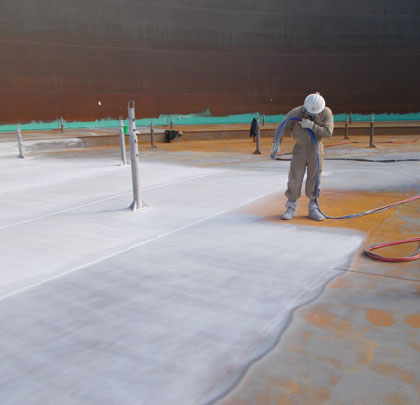Many industrial facilities, such as petrochemical plants, must remain safely, efficiently operational with virtually no downtime, unplanned maintenance, or replacement for decades. To protect equipment from corrosion, traditionally three separate coatings are used, often in a zinc, epoxy, and urethane combination. While this is common, it is far from optimal.
THE TYPICAL COATING
From a safety standpoint, urethane topcoats can be slick walking surfaces, prone to slip and fall hazards, particularly if walking surfaces are wet, moist, or humid. Typical exterior coatings, such as epoxy and urethane, can emit hazardous VOCs, HAPs, and odors during application, and may have flash points that require extra distance or caution when used around hot or flammable processes.
Applying traditional coatings can stop production for days, since they usually require substantial metal surface preparation, a prime coat, and two topcoats with at least 8 hours of drying time, also known as minimum recoat time, between each. Bad weather or environmental conditions can further delay production and even require reblasting the surface, if an environmental delay exceeds the coating’s maximum recoat time.
“Traditional coatings in some cases have significant drawbacks,” says Jay Harris, a project manager for Mobley Industrial Services, a multi-service specialty contractor serving the chemical, petrochemical, and refining industries. “They need extensive surface prep and must meet specific conditions, including minimum and maximum recoat times, before they can be applied. Due to this, it can take a few days or longer to apply three coats, depending on the size of the job and environmental conditions. To avoid overspray issues, hand-rolled application is often required.”
Seeking a better solution at a petrochemical facility on the Gulf Coast, Harris recently used a newly approved corrosion coating called EonCoat, by a Wilson, North Carolina-based company of the same name, to enhance workplace safety and return an approximately 35,000-square-foot floating roof tank to service in about half the time required by typical coatings.
THE CORROSION COATING
The corrosion coating is part of a new category of tough, Chemically Bonded Phosphate Ceramics (CBPCs) that can stop corrosion and extend equipment life. In contrast to typical paint polymer coatings which sit on top of the substrate, the anti-corrosion coating bonds through a chemical reaction with the substrate, and slight surface oxidation actually improves the reaction. This makes it impossible for corrosion promoters like oxygen and humidity to get behind the coating the way they can with ordinary paints. The corrosion barrier is covered by a true ceramic shell, which resists corrosion, fire, water, abrasion, chemicals, and temperatures up to 1,000 degrees F.
Ceramic coatings, such as this, consist of two, non-hazardous ingredients that do not interact until applied by a plural component spray gun like those commonly used to apply polyurethane foam or polyurea coatings. Since the components are not mixed and do not meet prior to application, the need for hazardous VOC-generating ingredients is eliminated, as are HAPs and odor. This means that the work can get done in occupied areas.
In contrast to traditional coatings that require three coats, one coat application and minimal prep for the protective ceramic coating provides facility maintenance managers with significant upfront savings. If the substrate is steel, a brush blast can knock off the loose rust so there is no need to sandblast until there is a bright metal surface for the coating to adhere. Once applied, the ceramic coating is dry to the touch in minutes, can be walked on in 15 minutes, and returned to service in about 1 hour.
While Mobley Industrial originally estimated over 20 shifts to blast and coat the floating tank roof with a conventional three-coat system, the project was completed in only 10 shifts using the ceramic coating.
ADDED BENEFITS
In comparing the ceramic coating to traditional coatings for petrochemical plants, Wesley Newburn, a Mobley Industrial Services quality control manager, points out additional advantages that can streamline the application and quality assurance process.
“For traditional coating application, the first step is to remove soluble salts to a permissible level, which includes site checks for chlorides, nitrates, and sulfates,” says Newburn. “If they are above the maximum levels allowed by the refinery, they must be removed by chloride and pressure washing. This normally will take at least one 10-hour shift. With the ceramic coating, there is no need for soluble salts to be removed, which is an advantage over any other coating in the industry.”
“Perhaps the biggest advantage with EonCoat is that there’s no worry about surface prep,” says Newburn. “You can blast the entire surface then coat it without concern over losing an acceptable blast. There’s no need for D-H equipment because the ceramic coating can be applied when it’s wet, humid, or even raining. A little surface oxidation makes it adhere better.”
According to Newburn, hydrocarbons are the number one cause of coating delamination at petrochemical facilities. To avoid coating delamination at refineries with traditional coatings, all hydrocarbons, such as oil and grease, must be found by black light methods, then removed by chloriding until black light passes. This is not required with the ceramic coating because it will not adhere to hydrocarbons, so on surfaces that are not clean the coating will “bubble” on the poorly prepared substrate.
“For enhanced corrosion protection, production uptime, as well as workplace and environmental safety, any industrial user who uses traditional coatings should consider EonCoat,” concludes Harris. ■
For More Information:
Del Williams is a technical writer based in Torrance, California. For more information on EonCoat, call 252.360.3110, or visit www.eoncoat.com.
_________________________________________________________________________
Modern Contractor Solutions, August 2013
Did you enjoy this article?
Subscribe to the FREE Digital Edition of Modern Contractor Solutions magazine.

One Coat Application


